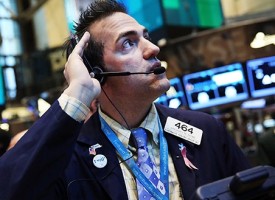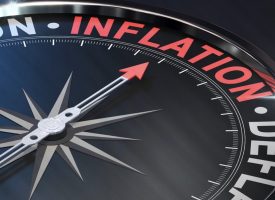Today King World News is sharing a piece from a top European firm which just warned, “We expect to see significant upheaval in coming years.”
“Markets don’t have a purpose any more—they just reflect whatever central planners want them to. Why wouldn’t it lead to the biggest collapse? My strategy doesn’t require that I’m right about the likelihood of that scenario. Logic dictates to me that it’s inevitable.” — Mark Spitznagel
By Ronald-Peter Stoeferle, Incrementum AG Liechtenstein
June 12 (King World News) – Throughout history, people who were involved in the production of money have tried to improve their situation by counterfeiting it. Those who were engaged in mintage used to lower the percentage of the coins’ purity and thus pushed the material value more and more below the nominal value. Later the banks, which originally kept the coins of their depositors and issued bank notes in return, began lending their depositors’ money to others, thus putting excessive banknotes in circulation. In each case the property rights of money owners were infringed, who received less than they were entitled to or were exposed to the risk of a bank run.
The development culminated in the counterfeits being legalized and that banks de jure were allowed to issue much more banknotes than they held in form of deposits. By this process, new money can be can be created through the granting of loans. That enriches – at the expense of others – the recipients of these loans as well as the banks which receive interest payments for lending money that they create from nothing.
The result is a house of cards made of loans whose architecture becomes all the more fragile the higher it is built: Defaults in payment can cascade around and cause the entire construction to collapse…
IMPORTANT…
To find out which junior a leader in the gold mining
industry just bought a 20% stake in CLICK HERE OR BELOW:
In order to prevent a contraction of money supply, a proactive monetary policy is required that creates permanent price inflation and growing money supply. The early recipients of new money will profit at the expense of the later ones, so debtors will be relieved at the expense of the creditors. This means that the maintenance of the credit money system, which is already based on the fact that property rights are infringed, leads to ever-increasing redistributive measures – and hence to an escalating infringement of property rights – as well as to an increasing systemic fragility as a result of the expanding amount of money.

In 1971, the US dollar was unanchored from Gold and the modern fiat money system was born. Money supply expansion was accelerated. Price inflation was structurally depressed, which allowed for even looser monetary policy. As a result, interest rates declined. Combined with financial innovations, the expansion of money supply entered a new dimension. However, during the global financial crisis the system was close to a collapse that could only be avoided by concentrated efforts of the governments and central banks.
After the GFC, the maxim of the central banks was the same as before the crisis: An even looser monetary policy should prevent a contraction in money supply and stimulate lending. As interest rates were reduced to zero to mitigate the crisis, the arsenal of monetary policy had to be expanded, e.g. by quantitative easing.
Since then, the world has obviously been caught in an exceptional monetary situation from which central banks want to escape in order to regain some leeway to react in case of another crisis. The Fed is the first central bank which dares to tighten its monetary policy by raising interest rates step by step.
But will the exit from the low interest-rate policy really succeed? With asset prices having reached dizzy heights due to low interest rates, can markets survive the withdrawal of monetary tailwind? Can central banks normalize monetary policy without causing the next crisis? Or is the world already caught in the zero interest trap?
We believe that zero interest rates are the end of a monetary impasse. Low interest rates have a number of distorting side effects for the economy. The following graphic gives an overview.

Conclusion
If the withdrawal from low interest rate policy is not successful, confidence in central banks around the world could crumble – a confidence which the stability of the post-Lehman economy is based on.
The above-named points make it seem rather unlikely that the monetary normalization will succeed, as the basis for it – namely a sustainable economic recovery – is lacking. An ambitious increase in interest rates will inevitably lead to a new crisis. Presumably, the Fed and other central banks will feel compelled to maintain the monetary tailwind – but this tailwind would further intensify the problems described above. Monetary policy as well as the entire financial system are therefore caught in a zero interest rate trap.
• A continuation of low interest rate policy distorts the economic structure and pushes pension funds, insurers and savers into a creeping ruin.
• A termination of low interest rate policy would mean risking a major recession/depression.
In our opinion, the current environment speaks for itself: purchasing gold as a hedge should be the order of the day for prudent investors.
Where will the gold price go next?
Two years ago, we made a quite audacious forecast, calling for gold to reach a price target of USD 2,300 by June 2018. At the current juncture that appears unlikely to happen. Nevertheless, the long term chart suggests that gold has pulled out of its rut. We continue to believe that the second phase of its secular bull market still lies ahead. There are numerous reasons for this:
1. The next US recession inevitably approaches – only the precise timing is open to question. It is not only certain that another recession will come, it is just as certain how central banks will respond to it: by switching back to (or intensifying) expansionary monetary policy, by implementing rate cuts, renewed rounds of quantitative easing, and quite possibly some form of “helicopter money” program. Should the next recession already begin before the process of policy normalization is finalized, confidence in the measures implemented to date could well crumble to disastrous effect. The following two criteria can be used to judge whether the Fed’s monetary policy normalization effort can be considered a success:
* positive real interest rates in a range from 1 to 2 percent are established. Based on the Fed’s consumer price inflation objective of 2%, this implies that nominal interest rates should increase to around 3.5%.
* the Federal Reserve’s balance sheet is reduced to pre-crisis levels.

According to what has been conveyed regarding the current state of debate at the federal open market committee (FOMC), a cautious reduction of the balance sheet is to be set into motion fairly soon (initially by stopping or tapering the re- investment of proceeds from maturing bonds – no specific figures were so far released though). Even if the Fed were to reduce its holdings of securities at the same pace at which it acquired them during its last QE program, i.e., if it were to reduce them by USD 85 billion per month, it would take until sometime in 2021 to shrink the monetary base to its pre-crisis level. From our perspective, one can essentially rule out that this can be done without triggering a recession.
2. Excessive global over-indebtedness is by now glaringly obvious. That not only applies to developed countries, but to many emerging markets as well. Moreover, all sectors of the economy are afflicted by huge debt burdens. “Growing one’s way out” of this mountain of debt appears essentially impossible. The easiest way out of the situation would be a significant devaluation of the US dollar (and of all other fiat currencies) against commodities, primarily against gold. In this way, outstanding debt (in fiat money terms) could be made sustainable again. The consequence would be high price inflation rates or a stagflationary environment. A side effect would presumably be that gold’s current undervaluation as a monetary asset relative to the total monetary base would at least decrease.

Since the end of the classical gold standard, parity between the US monetary base and US gold reserves was already restored on two occasions by an upward revaluation of gold (in the mid 1930s and in the late 1970s). Whether a potential dollar devaluation will happen in the framework of an international agreement or in an uncoordinated manner remains to be seen.
3. De-dollarization has begun. We regard this process as an uncoordinated form of dollar devaluation. Its main symptom is a gradual reduction of the US dollar’s importance as a global reserve currency. If central banks want to hold a monetary asset that is liquid, stateless and above all requires no counterparty, it is not debt securities denominated in other fiat currencies, but gold that represents the only real alternative. That should become particularly obvious if or when the currently still preferred foreign exchange reserves are devalued as the associated securities held in central bank portfolios suffer price declines, and central banks come under political pressure.
4. Occurrence of a “black or gray swan” event. Numerous potential financial shocks can be envisaged in the current environment. Regardless of whether such a shock is triggered by geopolitical tensions boiling over, or by negative economic developments – an appropriate allocation to gold will mitigate the negative performance of assets that typically generate large losses in the wake of such events.
5. Based on our analysis of market structure, sentiment and price patterns, our assessment is that the medium to long term technical picture looks promising. Speculative positions in futures markets have corrected sufficiently to create a healthy basis for the advance to resume. The Coppock curve gave a long term buy signal in late 2015, while sentiment data indicate that skepticism in the market remains quite pronounced. We expect only little upside momentum in the short term though, primarily based on seasonality, but also due to a number of signals from technical indicators that remain in bearish territory.
 “We Expect To See Significant Upheaval In Coming Years”
“We Expect To See Significant Upheaval In Coming Years”
Of course, the future is always uncertain, hence we want to present several scenarios outlining potential future gold price developments. The US dollar’s status as the senior global reserve currency remains (for now) a constant that is underlying all of them. That is also why we believe that economic developments in the US remain crucial for the price trend of gold. Since financial markets have fundamentally reassessed what the coming years are likely to bring in the wake of the US presidential election, we align the time-line of our scenarios with the Trump administration’s term of office, which should last until early 2021. From our perspective, the decisive factors for the gold price will be the momentum of GDP growth, as well as the further progress made in terms of the Fed’s monetary policy normalization effort.
Given the analyses presented in this year’s In Gold We Trust report, it shouldn’t be too big a surprise that we assign the highest probability to the latter two scenarios. Similar to the 1930s and the 1970s, these scenarios would be difficult to navigate, but at the same time provide quite interesting investment opportunities. The product range of Incrementum includes strategies that are specifically tailored to these scenarios.
If the bull market in precious metals continues, the performance of mining stocks will be decidedly positive. Investors should continue to place their bets with conservatively managed companies in the sector, which rather than pursuing a “growth at any price” agenda are focused on delivering strong returns to shareholders. From a valuation perspective, growth in free cash flows, gold reserves/resources per share, and earnings growth per share strike us as the most important metrics.
This is a sector in which one must be particularly careful to avoid getting diluted by a flood of share issuance. The sector’s small size in terms of total market capitalization is both a blessing and a curse. A blessing because outsized price gains can be achieved in boom times, and a curse because the flood of money flowing into the sector during bull markets invariably tempts managers of gold and silver mining companies to misallocate capital as they are constantly under pressure to “do something”. This danger is usually particularly pronounced in the late stages of bull markets, once everyone’s memories of the hardships of the bust period of the cycle have faded. In our investment process, we are currently focused on developers and emerging producers. Based on the premise that the bull market in gold has resumed, we expect the gold-silver ratio to decline over the medium term. In this scenario pure play silver mining stocks should offer particularly interesting investment opportunities.
In summary, we expect to see significant upheaval in coming years, with noticeable effects on the gold price. We will monitor events very carefully and provide commentary on a regular basis.
***KWN has now released the powerful audio interview with London whistleblower and metals trader Andrew Maguire and you can listen to it by CLICKING HERE OR ON THE IMAGE BELOW.
***ALSO JUST RELEASED: Everyone In The World Should Watch For This Historic Signal To Go “All-In” On Gold CLICK HERE.
***KWN has also released the remarkable KWN audio interview with Dr. Stephen Leeb, where he discusses what the historic signal will be to backup the truck to buy gold and much more CLICK HERE OR ON THE IMAGE BELOW.
© 2017 by King World News®. All Rights Reserved. This material may not be published, broadcast, rewritten, or redistributed. However, linking directly to the articles is permitted and encouraged.










